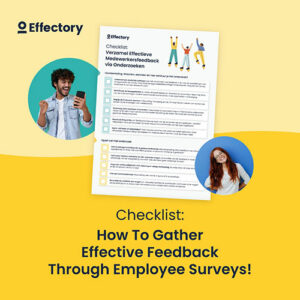At Effectory we believe that employee engagement and organizational success go hand in hand. Based on our clients’ experience, we decided to list what we consider the 7 best employee engagement ideas next to some employee engagement examples.
Employee Engagement strategies: the top 7 according to Effectory

Employee engagement ideas to create and support a performance environment in your organization.
Engaged employees feel an intrinsic motivation to succeed and they feel that their contributions are valued within the company. At Effectory, we see that engagement is tighly linked to a higher producivity and performance. Therefore, having a clear picture of your company’s level of employee engagement is crucial.
What is an employee engagement survey?
1. Among the best employee engagement examples: foster a strong company culture
At Effectory we use 3 simple items to check the levels of satisfaction with the company culture:
- How proud employees are of their organisation
- Employees’ fit with company culture
- Employees’ feeling of appreaciation from the organization
Strong company cultures usually establish better, more productive relationships among colleagues. Experience has taught us that when employees are positive about the three aspects above, it indicates the presence of a compelling company culture.
Employees are proud to work for organizations that have a positive impact on society. Make sure to outline a clear company mission and share it in any relevant occasion.
Five employee engagement models every HR professional need to know
2. Enabling employees with the tools they need to do their job
In our increasingly digital and technological world, businesses need to find a way to keep up. Make sure that you have the right tools in place for people to do their best work. This might mean investing in a bit more expensive and newer technologies to keep employees interested, engaged, and performing their best.
Benefits of measuring employee engagement
3. Providing regular recognition and feedback as engagement strategy.
As Gordon Tredgold says, “Employee recognition is directly tied to employee engagement”. It is becoming increasingly necessary to invest in good employee feedback tools (and this is especially true in the GDPR era).
With frequent feedback, you’ll be able to keep track of your organization’s heartbit. For example, you could choose a (bi)annual survey with more focused pulse surveys. Otherwise, create a continuous employee listening lanscape to reveal insights into what’s really going on.
Benefits of employee listening
A Nike case showed us how important it is to regularly conduct employee engagement surveys – you might not love what comes to the surface, but only then can you tackle what really matters to your employees. An important factor for this third employee engagement idea is to not only ask your employees to give you feedback; give them feedback too.
Discover the value of employee engagement in human resource management
How to gather feedback from your employees
The definitive checklist for creating your employee engagement survey.
Download4. Promoting life-work balance to foster employee engagement
Everyone’s talking about work-life balance with flex hours, flex vacation time, working from home, on-location daycare.
We might not have figured it all out, but when we’re talking about employees’ energy and health – which ultimately affects the performance of the entire organization – we really do focus on life-work balance. Ensuring employees are able to balance the two ultimately means lower levels of burnout, disengagement and turnover.
Sixty percent of employees more likely to experience burnout due to coronavirus crisis
5. Creating rewarding career paths
One question we hear frequently is how to develop talent and keep employees from leaving. Investing in employees only to see them walk out the door is an issue for most multinationals.
To retain talent, for this you have to offer them the necessary tools to succeed and grow, both personally and professionally. It’s important to look at how your employees can adapt to new positions in your organization and acquire new skills accordingly.
Keep in mind though, that employees will inevitably exit your organization and this is also an opportunity for continued shared success: by running an exit survey you can learn what you could have done better as an employer.
The best tips on how to improve employee engagement in your company
Checklist: 5 tips for Reboarding Employees
Are your employees still working at home or at the office again? Or a combination of both? We are happy to share practical tips for reboarding employees.
Download6 key criteria to find the right employee engagement survey provider
6. Seeing more than just your employees
If you want a great culture and true employee engagement, provide benefits that positively impact not only your employees but also their loved ones.
While they might be your employee, they are also a parent, spouse, sibling, child, caregiver or neighbor. See your employees as real people and you may just unlock the door to increasing employee engagement.
This ties back to company culture, which all too often is made up of employees with a myriad of cultural backgrounds.
7. Focusing on the employee experience
Organizations put a lot of effort in making sure customers have the best possible experience because they know how much negative conversations can harm your organization’s reputation.
In the same way, you have to take into consideration the employee experience – that means everything, from first contact to the exit interview. As Mark Levy, former head of Employee Experience (EX) at Airbnb, said, “Anything that sets employees up for success or improves our culture should be a part of the employee experience (EX)” Anticipate your employees’ needs and go out of your way to meet them.
Read also: The difference Between Employee Experience and Engagement
Book a free demo. See our solutions in action.
Effectory is Europe’s Leading provider of Employee Listening Solutions. Schedule a product demo and discover how to enhance your employees’ engagement.
Demo request

